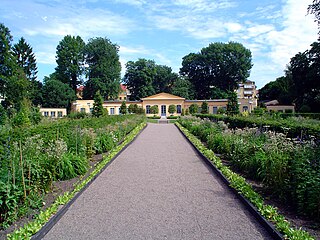In biology, a tribe is a taxonomic rank above genus, but below family and subfamily. It is sometimes subdivided into subtribes. By convention, all taxonomic ranks from genus upwards are capitalized, including both tribe and subtribe.

The International Code of Nomenclature for algae, fungi, and plants is the set of rules and recommendations dealing with the formal botanical names that are given to plants, fungi and a few other groups of organisms, all those "traditionally treated as algae, fungi, or plants". It was formerly called the International Code of Botanical Nomenclature (ICBN); the name was changed at the International Botanical Congress in Melbourne in July 2011 as part of the Melbourne Code which replaced the Vienna Code of 2005.

In botanical nomenclature, a form is one of the "secondary" taxonomic ranks, below that of variety, which in turn is below that of species; it is an infraspecific taxon. If more than three ranks are listed in describing a taxon, the "classification" is being specified, but only three parts make up the "name" of the taxon: a genus name, a specific epithet, and an infraspecific epithet.

A botanical name is a formal scientific name conforming to the International Code of Nomenclature for algae, fungi, and plants (ICN) and, if it concerns a plant cultigen, the additional cultivar or Group epithets must conform to the International Code of Nomenclature for Cultivated Plants (ICNCP). The code of nomenclature covers "all organisms traditionally treated as algae, fungi, or plants, whether fossil or non-fossil, including blue-green algae (Cyanobacteria), chytrids, oomycetes, slime moulds and photosynthetic protists with their taxonomically related non-photosynthetic groups ."

The International Association for Plant Taxonomy (IAPT) is an organization established to promote an understanding of plant biodiversity, facilitate international communication of research between botanists, and oversee matters of uniformity and stability in plant names. The IAPT was founded on July 18, 1950, at the Seventh International Botanical Congress in Stockholm, Sweden. The IAPT headquarters is located in Bratislava, Slovakia. Its president, since 2017, is Patrick S. Herendeen of the Chicago Botanic Garden; vice-president is Gonzalo Nieto Feliner of the Real Jardín Botánico, Madrid; and secretary-general is Karol Marhold of the Plant Science and Biodiversity Centre, Slovak Academy of Sciences, Bratislava.
Nomenclature codes or codes of nomenclature are the various rulebooks that govern biological taxonomic nomenclature, each in their own broad field of organisms. To an end-user who only deals with names of species, with some awareness that species are assignable to families, it may not be noticeable that there is more than one code, but beyond this basic level these are rather different in the way they work.

James Lauritz Reveal was a U.S. botanist best known for his contributions to the genus Eriogonum and for his work on suprageneric names. His website, at PlantSystematics.org, also presents material on plant taxonomy including the Reveal system. He published extensively on North American flora, was a member of the Angiosperm Phylogeny Group, and was one of the authors of the APG II and APG III classifications.
A conserved name or nomen conservandum is a scientific name that has specific nomenclatural protection. That is, the name is retained, even though it violates one or more rules which would otherwise prevent it from being legitimate. Nomen conservandum is a Latin term, meaning "a name to be conserved". The terms are often used interchangeably, such as by the International Code of Nomenclature for Algae, Fungi, and Plants (ICN), while the International Code of Zoological Nomenclature favours the term "conserved name".

Randall James Bayer is an American systematic botanist born in Buffalo, New York, who spent his childhood in East Aurora. He earned a B.Sc. with major in plant breeding and minor in horticulture in 1978 from Cornell University; an M.Sc. in systematic botany in 1980 from the Ohio State University; and a Ph.D. in 1984 from the Ohio State University with the dissertation Evolutionary Investigations in Antennaria. His interest in the genus Antennaria was inspired by noted evolutionary botanist George Ledyard Stebbins (1906–2000) who was a visiting professor at the Ohio State University in 1978–1979.

Nikolai Stepanovich Turczaninow was a Russian botanist and plant collector who first identified several genera, and many species, of plants.
The Australian Plant Name Index (APNI) is an online database of all published names of Australian vascular plants. It covers all names, whether current names, synonyms or invalid names. It includes bibliographic and typification details, information from the Australian Plant Census including distribution by state, links to other resources such as specimen collection maps and plant photographs, and the facility for notes and comments on other aspects.

Trimerophytopsida is a class of early vascular plants from the Devonian, informally called trimerophytes. It contains genera such as Psilophyton. This group is probably paraphyletic, and is believed to be the ancestral group from which both the ferns and seed plants evolved. Different authors have treated the group at different taxonomic ranks using the names Trimerophyta, Trimerophytophyta, Trimerophytina, Trimerophytophytina and Trimerophytales.
The Kew Rule was used by some authors to determine the application of synonymous names in botanical nomenclature up to about 1906, but was and still is contrary to codes of botanical nomenclature including the International Code of Nomenclature for algae, fungi, and plants. Index Kewensis, a publication that aimed to list all botanical names for seed plants at the ranks of species and genus, used the Kew Rule until its Supplement IV was published in 1913.
Hermenegild Santapau (1903-1970) was a Spanish born naturalized Indian Jesuit priest and botanist, known for his taxonomical research on Indian flora. He was credited with the Latin nomenclature of several Indian plant species. A recipient of the Order of Alphonsus X the Wise and the Birbal Sahni Medal, he was honoured by the Government of India in 1967, with the award of Padma Shri, the fourth highest Indian civilian award for his contributions to the society.

Daniel Atha is a botanist. In his work as a botanist he has collected plants in all 50 states of the United States, as well as several additional countries. Atha's work was focused on three areas: "floristics—what plants grow in a particular region; taxonomy—how to tell one plant from another, what to call it and what it's related to; and applied botany—how plants are used for food, medicine, shelter and other useful purposes." Atha has been known as a prominent regional botanist, and the high-profile botanical projects with which he has been involved have garnered national and international attention.
Barbara Lynette Rye is an Australian botanist born in 1952.

Patricia Holmgren is an American botanist. Holmgren's main botanical interests are the flora of the U.S. intermountain west and the genera Tiarella and Thlaspi. Holmgren was the director of the herbarium at the New York Botanical Garden from 1981–2000, and editor of Index Herbariorum from 1974–2008.
Sofya Georgiyevna Tamamshyan (1901–1981) was a Russian-Soviet botanist and plant taxonomist noted for describing 7 genera and more than 50 species, and for authoring over 120 works. The standard author abbreviation Tamamsch. is used to indicate this person as the author when citing a botanical name.
Laurence "Larry" Joseph Dorr is an American botanist and plant collector. He specializes in the systematics of the order Malvales and the family Ericaceae.
Cardamine incisa is a species of flowering plant in the mustard family Brassicaceae.










